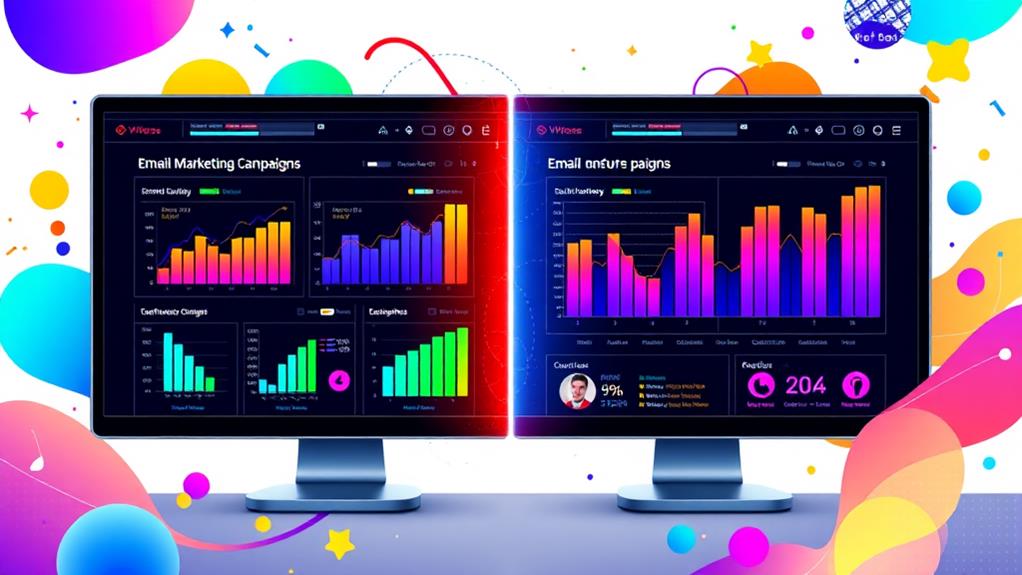Predictive analytics in 2024 empowers email campaigns by analyzing customer data to forecast behaviors and tailor content. By leveraging data-driven insights, businesses can enhance segmentation strategies, resulting in a 14% increase in email open rates. Ideal content timing, aided by machine learning, promises open rate enhancements of up to 200%. Personalized content, informed by predictive models, remarkably boosts click-through rates and conversions, especially recovering up to 15% of lost sales. Additionally, hyper-targeted communications can improve customer loyalty by 70%. Exploring these strategies can reveal further opportunities for achieving superior email marketing outcomes.
Key Takeaways
- Predictive analytics enhances segmentation, leading to a 14% increase in email open rates through dynamic audience targeting.
- Smart send-time optimization improves email timing, potentially increasing open rates by up to 200% with precise scheduling.
- Tailored content and predictive models boost click-through rates, optimizing engagement based on past customer interactions.
- Predictive insights refine conversion strategies, potentially increasing conversion rates by 20% with personalized messaging and follow-ups.
- Personalized engagement strategies using predictive analytics can enhance customer loyalty by up to 70% through data-driven communications.
Leveraging Customer Data
In today's data-driven marketing landscape, the strategic use of customer data is pivotal for crafting effective email campaigns. Marketers can utilize customer data analysis to create segments based on behavior, purchase history, and preferences. This segmentation allows for the delivery of highly targeted and relevant email content, which can considerably boost engagement metrics.
However, as companies explore deeper into customer insights, data privacy and ethical considerations must remain at the forefront. Ensuring compliance with regulations such as GDPR and CCPA is essential to maintain consumer trust and prevent legal repercussions.
Predictive analytics further enhances the potential of customer data by forecasting future behaviors. By integrating historical data with advanced predictive models, marketers can anticipate customer needs with remarkable accuracy. This enables the optimization of email timing, ensuring messages are delivered when recipients are most likely to engage.
Additionally, personalizing content at scale—tailoring subject lines, visuals, and offers—becomes feasible, ultimately increasing open and click-through rates.
Continuous refinement and dynamic audience targeting, grounded in ethical data practices, can boost campaign effectiveness. The judicious use of customer data, balanced with privacy concerns, is central to driving engagement and fostering long-term customer loyalty.
Enhancing Segmentation Strategies
Building upon the strategic use of customer data, enhancing segmentation strategies through predictive analytics becomes a powerful tool for marketers aiming to refine their email campaigns. By analyzing behavioral patterns and purchase history, predictive analytics enables dynamic audience segmentation, allowing for highly targeted email communications. This approach leverages predictive modeling to identify trends and forecast customer behaviors, facilitating the creation of segments that are more likely to engage and convert.
Advanced segmentation tools, powered by AI, continuously refine these customer groups based on real-time interactions, ensuring that email content remains both relevant and timely. Such refined segmentation strategies have demonstrated tangible benefits, evidenced by a 14% increase in open rates and a 10% rise in click-through rates. This data-driven approach not only enhances campaign effectiveness but also optimizes email send times.
AI-driven smart send-time optimization targets recipients when they are most likely to check their emails, further boosting engagement. Incorporating predictive analytics into segmentation strategies allows marketers to move beyond static lists and embrace a more fluid, responsive approach. This method aligns closely with consumer expectations, providing personalized experiences that drive better performance in email marketing campaigns.
Boosting Engagement Rates
Many marketers find that boosting engagement rates in email campaigns hinges greatly on the strategic application of predictive analytics. Leveraging behavior analysis, predictive models dissect past interaction data to craft dynamic content tailored to individual preferences. This personalization strategy markedly improves click-through rates by matching content with recipient interests. Furthermore, predictive analytics enhance subject line and content optimization, leading to a 20% uplift in engagement rates by guaranteeing messages are relevant and timely.
An essential element of this approach is identifying audience segments most likely to engage. By analyzing behavioral patterns, marketers can design hyper-targeted campaigns that resonate deeply, offering content that aligns with specific interests.
| Predictive Analytics Strategy | Resulting Impact on Engagement |
|---|---|
| Ideal Timing Delivery | Increased Open Rates |
| Tailored Content Creation | Boosted Click-Through Rates |
| Audience Segmentation | Hyper-Targeted Campaigns |
| Subject Line Optimization | 20% Increase in Engagement |
Additionally, predictive insights allow for the anticipation of customer needs, resulting in a 15% improvement in conversion rates by delivering timely offers. The ability to provide content that adapts dynamically to recipient behavior guarantees that email campaigns remain not only engaging but also highly effective in converting interest into action.
Optimizing Content Timing
Timing can be everything when it comes to maximizing the success of email campaigns. By leveraging predictive analytics, marketers can refine their send time strategies to considerably enhance engagement timing. Analyzing historical customer behavior allows for the identification of ideal email sending times, which can increase open rates by up to 200%. This precision in timing guarantees that emails land in the recipient's inbox at moments when they are most receptive.
Machine learning algorithms play an essential role in refining content timing by determining the best days and times to target specific customer segments. This approach can lead to a 20% improvement in click-through rates, as emails are more likely to be opened and engaged with when sent at the right moment.
Additionally, employing smart send-time optimization features in email platforms allows for the automatic scheduling of emails, maximizing recipient engagement and enhancing overall campaign effectiveness.
Predictive models not only improve engagement but also reduce unsubscribe rates by 25% through improved relevance and timing. This fosters better customer relationships and guarantees that communications are delivered when recipients are most likely to engage, driving up conversion rates by as much as 15%.
Driving Conversion Growth
Through strategic application of predictive analytics, marketers can considerably enhance conversion growth by delivering hyper-targeted and timely content. By utilizing predictive insights, businesses are empowered to refine their conversion funnel, guaranteeing that each stage is optimized for maximum efficiency.
For instance, predictive modeling identifies customers most likely to convert, allowing for a 20% enhancement in conversion rates. This precise targeting guarantees that marketing efforts are concentrated on high-potential leads.
Predictive analytics also drives conversion growth by improving email open rates by up to 29% through personalized messaging.
Here are four key strategies:
- Identify Key Audiences: Leverage predictive insights to pinpoint individuals within the conversion funnel who are most likely to engage, guaranteeing resources are allocated efficiently.
- Personalize Recommendations: Use historical purchase data to tailor product suggestions, increasing click-through rates by 50% compared to generic emails.
- Optimize Timing: Schedule emails for peak engagement times, potentially boosting conversion rates by 30%.
- Reduce Cart Abandonment: Deploy timely follow-up emails to recover up to 15% of lost sales, addressing a critical point in the conversion funnel.
Fostering Customer Loyalty
In fostering customer loyalty, predictive analytics plays an essential role by enabling personalized engagement strategies that are both data-driven and effective.
By leveraging insights from customer purchase history and behavior, companies can tailor communications and product recommendations, enhancing satisfaction and encouraging repeat business.
In addition, segmentation through predictive models allows for hyper-targeted campaigns, which, according to recent studies, can improve customer loyalty by up to 70%.
This demonstrates the significant impact of data-driven relationship building.
Personalized Engagement Strategies
Harnessing the power of predictive analytics, personalized engagement strategies have emerged as pivotal in fostering customer loyalty by tailoring email content to individual preferences and behaviors.
By leveraging behavioral triggers and dynamic content, businesses can greatly enhance their email campaigns' effectiveness. Predictive analytics allows marketers to anticipate customer needs, thereby facilitating a 5.8% conversion rate for automated back-in-stock emails. This strategy not only boosts customer satisfaction but also cultivates loyalty.
- Increased Open Rates: Personalized emails, driven by predictive insights, can increase open rates by up to 29%. This is achieved by aligning the email content with the customer's past interactions and preferences.
- Conversion Rate Growth: Automated emails, such as those notifying customers of back-in-stock items, benefit from predictive models, resulting in higher conversion rates and enhanced customer loyalty.
- Enhanced Retention: Segmenting audiences based on predictive insights allows for hyper-personalized campaigns, leading to a 27% boost in customer retention rates.
- Improved Click-Through Rates: AI-driven personalization, such as recommending products based on previous purchases, can raise click-through rates by 10%, making customers feel valued.
Implementing these personalized strategies guarantees a more engaged audience, ultimately fostering long-term customer loyalty.
Data-Driven Relationship Building
Utilizing predictive analytics as a cornerstone, data-driven relationship building has transformed how businesses foster customer loyalty. By leveraging behavioral insights and predictive modeling, marketers can anticipate customer preferences and behaviors, crafting personalized email content that resonates on an individual level. This tailored approach not only deepens connections but also enhances loyalty, as customers are more likely to engage with content that aligns with their interests.
Analyzing historical data through predictive models allows for the identification of products or services a customer might favor. This leads to more relevant and engaging email campaigns, strengthening brand loyalty by meeting customer expectations proactively. Such precision in targeting can increase customer retention rates by up to 5-10%, as personalized communications encourage repeat purchases.
Furthermore, data-driven insights empower marketers to segment their audiences effectively, ensuring that loyalty-building efforts are precisely targeted. This relevance is essential in maintaining each customer's unique journey, as evidenced by personalized emails achieving open rates as high as 29% and click-through rates of 5.5%.
Fundamentally, predictive analytics not only enhances customer engagement but also fosters long-term loyalty, establishing a sustainable competitive advantage in the digital marketplace.
Frequently Asked Questions
How Does Predictive Analytics Handle Data Privacy Concerns in Email Campaigns?
Predictive analytics addresses data privacy concerns in email campaigns through data anonymization strategies, ensuring individual identities remain protected. Additionally, consumer consent management is implemented, allowing individuals to control their personal information, thereby enhancing transparency and trust in data handling.
What Tools Are Recommended for Implementing Predictive Analytics in Email Marketing?
For effective implementation of predictive analytics in email marketing, tools like Tableau for data visualization and IBM Watson for advanced segmentation strategies are recommended. These tools offer detailed insights, enabling data-driven decisions and optimized campaign performance.
How Can Small Businesses Afford Predictive Analytics for Email Campaigns?
Small businesses can utilize cost-effective solutions by adopting budget-friendly tools like Mailchimp, HubSpot, or Sendinblue, which offer predictive analytics features. These platforms deliver data-driven insights, enabling businesses to enhance campaign effectiveness without exceeding financial constraints.
What Role Does Artificial Intelligence Play in Predictive Analytics for Emails?
Artificial intelligence markedly enhances predictive analytics by utilizing AI algorithms for sophisticated data segmentation. This enables detailed analysis of user behavior, facilitating precise campaign optimization and ensuring more personalized, targeted email strategies that boost engagement and conversion rates.
Are There Any Case Studies Showing the Success of Predictive Analytics in Email Marketing?
Case study examples highlight predictive analytics' effectiveness in email marketing, demonstrating success metrics such as increased open rates, higher conversion rates, and improved customer engagement. These metrics underscore predictive analytics as a transformative tool for optimizing email campaigns.
Conclusion
The integration of predictive analytics into email campaigns offers significant advantages by utilizing customer data to refine segmentation strategies, thereby boosting engagement rates. Optimizing content timing further enhances the efficacy of these campaigns, leading to increased conversion rates. Additionally, predictive analytics fosters customer loyalty by delivering personalized content that resonates with individual preferences. As organizations continue to harness these capabilities, the potential for achieving superior marketing outcomes in 2024 is considerable, underscoring the importance of data-driven decision-making in the digital marketing landscape.




